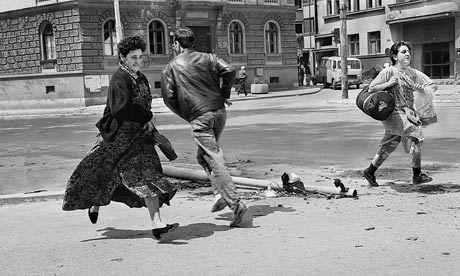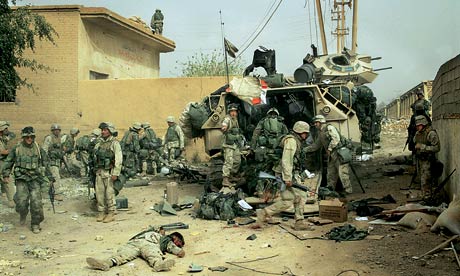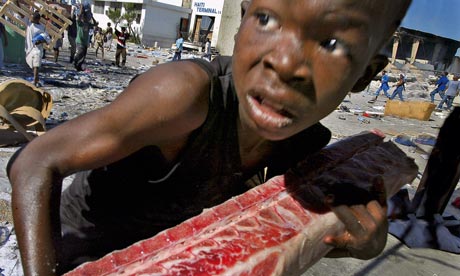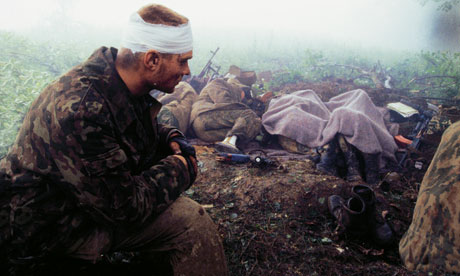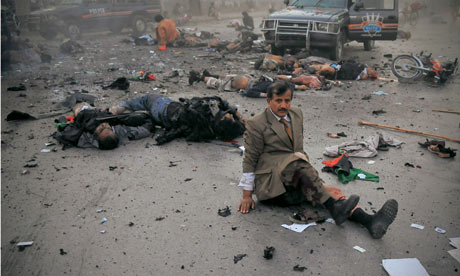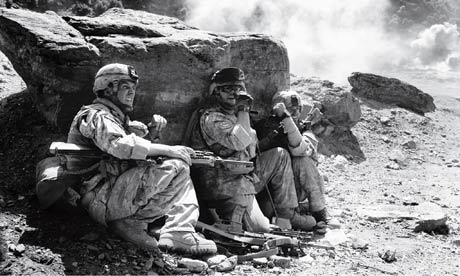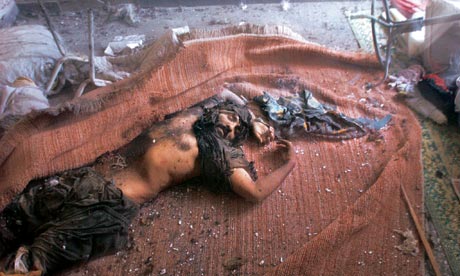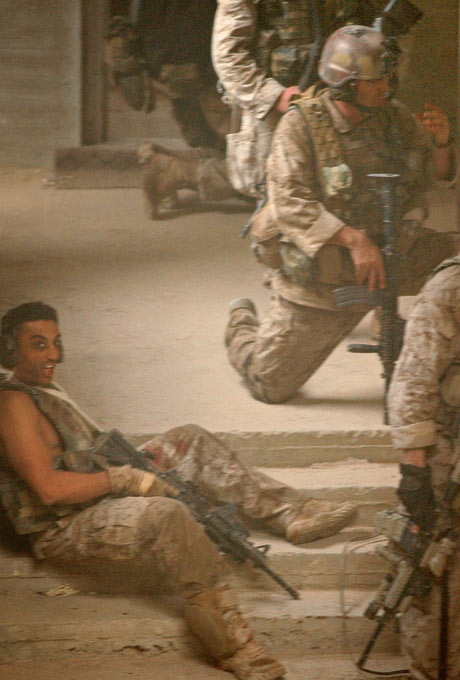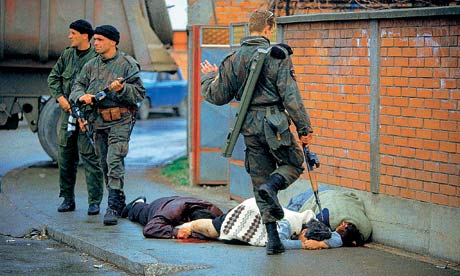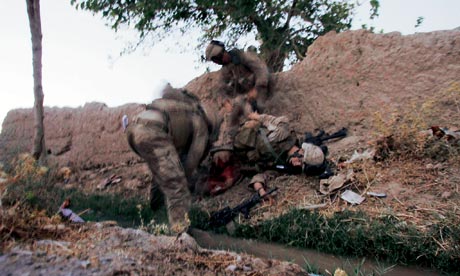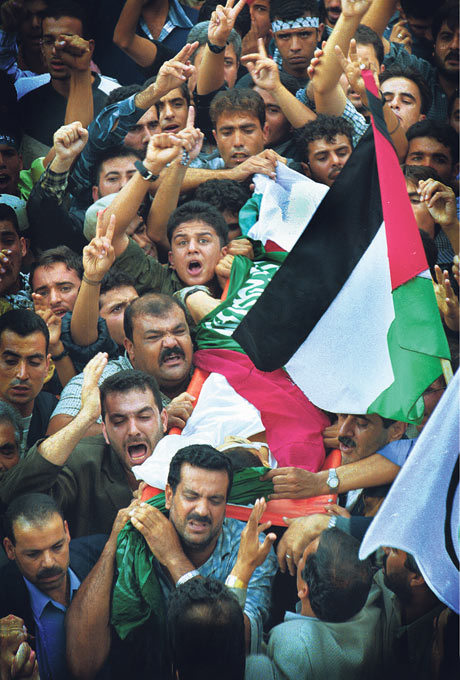Adam Ferguson: 'As a photographer, you feel helpless. Around you are medics, security personnel, people doing good work. It can be agonisingly painful to think that all you're doing is taking pictures.' Photograph: Adam Ferguson/VII Network
I was one of the first on the scene. The Afghan security forces normally shut down a suicide bombing like this pretty quickly. I was able to get to the epicentre of the explosion. It was carnage, there were bodies, flames were coming out of the buildings. I remember feeling very scared because there was still popping and hissing and small explosions, and the building was collapsing. It was still very fresh and there was a risk of another bomb. It was one of those situations where you have to put fear aside and focus on the job at hand: to watch the situation and document it.
This woman was escorted out of the building and round this devastated street corner. It epitomised the whole mood – this older woman caught in the middle of this ridiculous, tragic event. I wish I could have found out how her life unravelled, but as soon as the scene was locked down, I ran back to the office to file.
As a photographer, you feel helpless. Around you are medics, security personnel, people doing good work. It can be agonisingly painful to think that all you're doing is taking pictures.
When I won a World Press award for this photograph, I felt sad. People were congratulating me and there was a celebration over this intense tragedy that I had captured. I reconciled it by deciding that more people see a story when a photographer's work is decorated.
Alvaro Ybarra Zavala, Congo, November 2008
Alvaro Ybarra Zavala: 'Years after i took this picture, every time I see it I feel scared again.' Photograph: Alvaro Ybarra Zavala/Getty
The situation was very tense – people were drunk and aggressive. I was with two other photographers most of the time, but at this moment I went back to the road alone. I saw three soldiers smoking, playing with their guns, and felt safe – I don't know why. Then I saw a man with a knife in his mouth, coming out of the bush – he was holding up a hand like a trophy. The soldiers started laughing and firing in the air. I didn't think about it and began shooting. He walked directly at me. People surrounded us, celebrating. I thought, "Don't do anything crazy, just act like you're part of this crazy party."
When I got to the hotel, I showed the other photographers. They said, "Do you realise you could have been killed?" Only then did it hit me how dangerous it had been. Years after I took this picture, every time I see it I feel scared again.
I really hate this shot. It's the worst face of humankind. I always ask myself, "Why do I do this job?' And the answer is: I want to show the best and worst face of humankind. Every time you go to a conflict, you see the worst. We need to see what we do to be able to show future generations the mistakes we make. The guy with the knife in his mouth is a human being like the rest of us. What's important is that we show what human beings are capable of. The day I don't do that with my photography is the day I'll give up and open a restaurant.
Lynsey Addario, Libya, March 2011
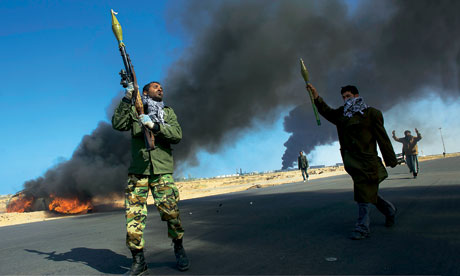 Lynsey Addario: 'They made us lie in the dirt, put guns to us. We were pleading for our lives.' Photograph: Lynsey Addario/VII Network
Lynsey Addario: 'They made us lie in the dirt, put guns to us. We were pleading for our lives.' Photograph: Lynsey Addario/VII Network
I had been in Libya for just over two weeks, shooting the insurgency. Pictures like this, of inexperienced rebels being fired on by machine guns and mortars. On 15 March, myself and three other journalists were captured by Gaddafi's troops. They made us lie in the dirt, put guns to us. We were pleading for our lives. They started groping me very aggressively, touching my breasts and butt. Then we were tied up, blindfolded and moved from place to place for six days.
The first three days were very violent – I was punched in the face several times, groped nonstop. At that point, it was hard to justify why I put myself in that situation. When our captors left us alone, we spoke about what we'd do if we got out. I said I'd probably have to get pregnant because I've put my husband through a lot – I was kidnapped in Fallujah in 2004, and I was in a car that flipped just months before our wedding. Some of us contemplated whether we wanted to continue covering conflicts; whether it was worth the hardships we put our families through.
When we got out, I felt surprisingly OK. We'd survived – when you survive, this job is always worth the risk. Then a few weeks later Tim Hetherington and Chris Hondros were killed in Misrata, which sent me into a tailspin. This job takes a lot of skill, but a lot of it is luck. When friends die, you wonder if it's worth the price.
João Silva, Afghanistan, October 2010
João Silva: 'As the soldiers dragged me away from the kill zone, I took these pictures. When people around me have been hurt or killed, I've recorded it. I had to keep working.' Photograph: João Silva/The New York Times
I'd been in Afghanistan for a month when I stepped on the landmine. I was the third man in line, and as I put my foot down, I heard a metallic click and I was thrown in the air. I knew exactly what had happened. As the soldiers dragged me away from the kill zone, I took these pictures. When people around me have been hurt or killed, I've recorded it. I had to keep working. The soldiers were yelling for the medics. I knew my legs had gone, so I called my wife on the satellite phone and told her not to worry. The pain came later, back in intensive care, when infections set in and they nearly lost me a couple of times.
I've spent enough time out there for my number to come up. I was one of the few who kept going back to Iraq. People think you do this to chase adrenaline. The reality is hard work and a lot of time alone. Firefights can be exciting, I'm not going to lie, but photographing the aftermath of a bomb, when there's a dead child and the mother wailing over the corpse, isn't fun. I'm intruding on the most intimate moments, but I force myself to do it because the world has to see those images. Politicians need to know what it looks like when you send young boys to war. If it's humanly possible, if the prosthetics allow me, I'll go back to conflict zones. I wish I was in Libya at the moment, without a shadow of a doubt.
Tom Stoddart, Sarajevo, 1992
Tom Stoddart: 'Sarajevo was the most dangerous place I have worked on a long-term basis. But I could leave. The occupants of the city could not.' Photograph: Tom Stoddart/Getty Images
I'm not really interested in military bang-bang pictures; I'm interested in documenting people living through war. Sniper Alley, where this was taken, paralysed Sarajevo. To get from one side to the other, the residents had to pass through this intersection and Serbian snipers would take shots at them. Bullets pinged past the entire time. Some people would sprint as fast as they could; others would brazenly walk, as if they were giving two fingers. Many were killed. Anyone who says they aren't frightened during war is either lying or a fool. It's about finding a way of dealing with the fear – you have to be very calm. You're not there to get your rocks off; you're there because you feel your pictures can make a difference. Sarajevo was the most dangerous place I have worked on a long-term basis. But I could leave. The occupants of Sarajevo couldn't. That was one of the strange things about covering it – it was so close to London. You could be back at Heathrow in a couple of hours. People would pass carrying skis, or off to the Caribbean, and you'd feel like screaming, "Why don't you understand?" You become a terrible dinner guest.
Greg Marinovich, Soweto, 1990
Greg Marinovich: ' "No pictures," someone yelled. I told them I'd stop shooting if they stopped killing him. They didn't.' Photograph: Greg Marinovich/Storytaxi.com
I was deep in Soweto when I saw a man being attacked by ANC combatants. The month before, I'd seen a guy beaten to death – my first experience of real violence – and hadn't shaken the feeling of guilt that I had done nothing to stop it. "No pictures," someone yelled. I told them I'd stop shooting if they stopped killing him. They didn't. As the man was set on fire, he began to run. I was framing my next shot when a bare-chested man came into view and swung a machete into his blazing skull. I tried not to smell the burning flesh and shot a few more pictures, but I was losing it and aware that the crowd could turn on me at any time. The victim was moaning in a low, dreadful voice as I left. I got in my car and, once I turned the corner, began to scream. You're not just a journalist or a human being, you're a mixture of both, and to try to separate the two is complicated. I've often felt guilty about my pictures. I worked in South Africa for years and was shot three times. The fourth and final injury, in Afghanistan in 1999, wasn't the worst, but I decided enough was enough. I was looking to settle. Nineteen months later, I met my wife.
Gary Knight, Iraq, April 2003
Gary Knight: 'My stress is nothing compared with civilians and soldiers. I remind myself of that all the time. I don't have to be there – they don't have the choice.' Photograph: Gary Knight/VII
This was at the start of the invasion. We were at the Diyala Bridge, which had to be taken by the marines so they could get into Baghdad. They were the lead battalion, the ones who went on to pull down the statue of Saddam. The opposition were shelling us. It was terrifying – both the actual shelling, and the anticipation of it. It comes in waves so you can see it moving in your direction. One had exploded in the tank. If it had landed on top or a couple of feet over, I would have died. Your instinct is to bury yourself, but you can't. You're there to do a job. The point is to get the news out. If you keep moving, you can manage the fear. And my stress is nothing compared with civilians and soldiers. I remind myself of that all the time. I don't have to be there – they don't have the choice.
My wife and children were very much on my mind because the danger was so extreme. You cannot separate the rest of your life and I've tried not to control how much I think about them. Sometimes they have been constantly in my head, sometimes I have not thought about them at all.
Shaul Schwarz, Haiti, February 2004
Saul Schwarz: 'I had blood on me, brains. I was crying, shaking. I ran to the car horrified. I was a mess.' Photograph: Shaul Schwarz/Getty
Port au Prince was falling. It was riotous, with widespread looting. A group of us had gone to the port. The thugs with guns didn't want us there. We snapped from the waist, trying not to make it obvious. We decided to go over the wall. One thug offered me "protection". As we jumped the wall, I saw this boy, and was like, "This is what it's come to." It was my first digital assignment and I was amazed to be able to look at my shots. I did for a second; when I looked up, everyone had run off. It was just me and the thug. It was like a dog that smells fear. He began pushing and threatening me. Then I was surrounded. One of them hit me. I had a few dollar bills in my trousers, and put my hand there. They began tearing at me, fighting over the bills. I waited 30 seconds, started to walk away, then ran and scaled the fence. On the other side, I tried to breathe.
I began shooting one guy a metre away. He screamed and pulled a shotgun. I saw the barrel, then he shot the man next to me – I had blood on me, brains. I was crying, shaking. I ran to the car horrified; I was a mess. I love Haiti, but every time I pass the port, I carry some of that fear.
Eric Bouvet, Chechnya, May 1995
'You see movies, you read books, you can imagine anything. But when you are in front of something, it's not like the movies.' Photograph: Eric Bouvet/VII Network
It was unbearable. Two crazy weeks and the most unbelievable story I ever did. I was with a Russian special commando. They were torturing, killing and raping. I saw them do it, and I couldn't stop them. Someone of a normal constitution can't accept that. I was working on the edge.
This is the morning after a night that left four men dead and 10 wounded. It was heavy fighting, and I was very afraid. I discovered a dead Chechen four metres from me when I got up in the night. You see movies, you read books, you can imagine anything. But when you are in front of something, it's not like the movies. We started out as 60 and came back 30 – one in two people injured or killed. I was lucky.
As soon as it was light, I took pictures. This is the first thing I saw. The guy with the bandage on his head has lost his friends. He has fought all night long. I don't feel pity, but at the same time they took me with them and did everything to protect me. Without them, I couldn't have done the story. I was the only witness. It's very complicated.
Mads Nissen, Libya, February 2011
Mads Nissen: 'Suddenly this guy jumped on the the tank. I'm not that interested in pictures of tanks burning – I'm interested in people. I had wanted to capture the sense of release that everyone had, and this became the shot.' Photograph: Mads Nissen/Berlingske/Panos Pictures
I got into Ajdabiya shortly after its fall. The rebels had just moved in and the locals were going crazy, shooting in the air. Bodies of pro-Gaddafi soldiers were lying around, beginning to stink as the sun got higher. The fire from the tank was incredibly strong and I was worried it might explode at any moment. Suddenly this guy jumped on to it. I'm not that interested in pictures of tanks burning – I'm interested in people. I had wanted to capture the sense of release that everyone had and suddenly this became the shot. I got as close as possible, within metres, and started shooting, counting to five in my head. Then I got out. I had seen corpses, torn apart, in the morgue and didn't want to end up like that. I took a chance – I had to; that was why I was there, to tell the story – but I made sure I wasn't too greedy.
Adam Dean, Pakistan, December 2007
Adam Dean: 'I'd never seen a dead body before. It was almost like a test to see if I had what I needed for this job.' Photograph: Adam Dean/Panos Pictures
I was very much a novice when I took this. I'd just finished a master's in photojournalism and thought I'd go to Pakistan to cover the elections. An attempt had been made on Bhutto's life two months earlier, so there was already a certain degree of risk.
I was about 15 metres away, photographing Bhutto, when there was a burst of gunfire followed by an explosion. I had a split-second decision to risk a secondary blast (as had happened in October) or start running with the crowd. I was panicking, trying to fight the urge to leave. I'd never seen a dead body before. It was almost like a test, to see if I had what I needed for this job.
As I approached the aftermath of the bomb, I struggled to compose myself. I was terrified and sickened, but kept telling myself just to concentrate and get it done so I could leave. I knew I had to frame the pictures so they weren't too graphic. The epicentre of the explosion was a pile of maybe a dozen limbless, charred, mangled bodies in pools of blood. This was one of the times I was most in danger, but there have been times in Afghanistan where I have felt more scared. This was over in seconds, but a firefight can go on for hours. The real worry is IEDs, though – when you go on patrol, every step could be your last. I'm 33 and I'm not sure I'd want to put myself in such risky situations when I'm older and perhaps have other people to consider.
John D McHugh, Afghanistan, May 2007
John D McHugh: 'We ran behind a Humvee… by that point I'd accepted that I was going to get shot – there were so many bullets in the air, it sounded like a swarm of bees.' Photograph: John D McHugh/Getty Images
This is the last picture I took before I got shot. I'd been embedded with US troops in Nuristan for five weeks when we went to help a unit that had been ambushed nearby. There were bodies on the road, dead and dying. Taliban started shooting down on us from the mountains. I jumped behind a rock. I could hear bullets hitting it, and thought, "Oh fuck, oh fuck."
We ran behind a Humvee, but now we were being fired on from both sides. By that point I'd accepted that I was going to get shot. There were so many bullets in the air, it sounded like a swarm of bees. They had us pinned down and a sniper was picking people off one by one.
The bullet went through my ribs and out of my lower back. It felt as if I'd been punched. I fell to my knees, but managed to get behind another rock. The entry wound was the size of a penny; the exit bigger than the palm of my hand. The pain was overwhelming. I was convinced I was going to die and felt angry with myself. Then I started worrying that I might live but end up paralysed. Maybe I was better off dead? My mind refocused and I thought, "No, fuck that!"
It was 25 minutes before anybody could get to me. My cameras were on the ground, and as they grabbed me I had to lean down and pick them up. When we got to the local base, a medic said, "Hell, I can see right through you." As soon as I knew that I'd recover, I told my girlfriend I was going to go back out. The work I do is important and also, if I hadn't, it would mean I'd never really understood the risks in the first place.
I love my job but getting shot made me think about life beyond work. I proposed to my girlfriend two months later, and we had a baby last year.
Marco di Lauro, Iraq, November 2004
Marco Di Lauro: 'I'm 40 now, and a lot has changed in the risks I'm prepared to take. When you're younger, you're immortal.' Photograph: Marco Di Lauro/Getty Images
This photograph was the most dangerous moment in my career. I was with two marines trying to get into this house. The first marine knocked down the door and the guy that you see in the image threw a grenade at him – the dust is from the explosion. Being behind the wall at the side of the front door saved me.The second marine entered the room and shot the Iraqi dead. I was the third person in the room and I took this picture.
I started when I was 28. I'm 40 now, and a lot has changed in the risks I'm prepared to take. When you're younger, you're immortal. Three days into my first assignment, I was photographing between two lines of people shooting at each other in Kosovo. I'm more scared now, more aware of the risks. I've lost a lot of friends and colleagues – two of them very recently. I'll keep doing the job I do but I'll be more careful.
John Stanmeyer, East Timor, August 1999
John Stanmeyer: 'The military turned their guns on him , and as her started to run they grabbed him and kicked him. Moments later, he was lying in a 20ft stream of blood. The military were very unhappy with the pictures afterwards.' Photograph: John Stanmeyer/VII
There were numerous firefights going on between the pro-Timorese Aitarak and the Indonesian militia, so I just ran. A bullet went right by my ear, moving my hair. It was fate that my head was tilted to the right, otherwise I wouldn't be here today.
Within minutes of nearly being killed, I came across pro-East Timorese independence supporter Joaquim Bernardino Guterres. The military turned their guns on him, and as he started to run they grabbed him and kicked him. Moments later he was lying in a 20ft stream of blood. The military were very unhappy with the pictures afterwards.
I don't think about the risk to myself, as I probably should. While I was out in Afghanistan, my wife had a miscarriage and she equated it to my being away. That was pretty dreadful, but she's a writer and understands why I do this. We've been to Sudan together, we've been ambushed, we've been in lots of nutty situations.
Ashley Gilbertson, Iraq, 2004
Ashley Gilbertson: 'Sometimes you look at images of war, and they're like a Hollywood producer's vision of what war is supposed to look like. There are very few pictures where you get a feel for how awful it is, how desperate and urgent.' Photograph: Ashley Gilbertson/VII Network
It was one of the most intense experiences I've ever had. I was with a lead unit of marines, and we received a triple ambush from the insurgents. I'd just run across a street with 40 marines to take shelter in an Islamic cultural centre, with bullets whizzing past my face. I thought, if I'm going to die right now, I might as well be working. I was in so much shock. It was a wake-up call to how violent it was going to be.
The guy in the photo is shouting, "Don't take my fucking picture!" Sometimes, you look at images of war, and they're like a Hollywood producer's vision of what war is supposed to look like. There are very few pictures where you get a feel for how fucking awful it is, how desperate and urgent. I like that it's not a clean picture, that it's not well composed and you can't see everything that's happening. That's part of it. It's so messy. It's the closest I've come to capturing the chaos of combat.
Ron Haviv, Bosnia, 1992
Ron Haviv: 'I was shaking when I took the shot. None of them was looking at me, so I lifted my camera, just trying to get them in frame. When I put it down, they looked over. They didn't realise I'd taken photos.' Photograph: Ron Haviv/VII
These are the Serbian warlord Arkan's men. They've just executed these Muslim civilians – a butcher, his wife and sister-in-law; the start of what became known as ethnic cleansing.
I had taken a photograph of Arkan with a baby tiger, which he'd liked, and he'd agreed for me to travel with his troops to photograph his "mission". The soliders were yelling at me not to shoot, but I'd promised myself I'd come out of this with an image to prove what was happening.
I was shaking when I took this shot. None of them was looking at me so I lifted my camera, just trying to get them in frame. When I put it down, they looked over. They didn't realise I'd taken photos.
Later, Arkan caught me photographing another execution and said he'd process my film and keep the ones he didn't like. I'd hidden the film from earlier in the day in my pocket and figured that if I fought hard enough for the film in my camera, he wouldn't search me.
When the pictures were published not long after, Arkan said in an interview, "I look forward to the day I can drink his blood." He put me on a death list, and I spent the next eight years trying to avoid him. Eventually, these images were used to indict him at The Hague.
Julie Jacobson, Afghanistan, August 2009
Julie Jacobson: 'The media ground rule was that you couldn't photograph a military casualty in a way that they could be identified… Making that decision was a public act. I got a lot of flak.' Photograph: Julie Jacobson/AP
We were hiding from Taliban gunfire, when there was this explosion. Afterwards, I saw [Lance Corporal Joshua M] Bernard – one of his legs was blown off and the other was barely there. He'd suffered a direct hit from an RPG [rocket-propelled grenade]. The media ground rule was that you couldn't photograph a military casualty in a way that they could be identified, but I could see Bernard's hand reach out to his weapon, his face turned to me. So I shot nine frames over two and a half minutes.
Making that decision was a public act. I got a lot of flak. Bernard later died, and people said that I didn't give him dignity, that I should have helped him. But I couldn't help him. For me to turn my back, that's disrespectful.
Ami Vitale, Gaza, October 2000
Ami Vitale: 'I was terrified, and thought, "This is it, I am going to die." Suddenly I understood a mob. There's no thinking, just passion.' Photograph: Ami Vitale/Panos Pictures
I was photographing a funeral, and having spent most of the day with the women, I went to see the body being taken in. A man in the procession started screaming, "CIA agent" and pointing at me. I was surrounded by hundreds of angry men, screaming in my face, grabbing me. I was terrified, and thought, "This is it. I am going to die." Suddenly I understood a mob. There's no thinking, just passion.
A woman I'd spent the day with managed to pull me away. When I got home, I sat and cried and cried – she had saved my life. I stayed on in Palestine, but was much more cautious after that; have been ever since. That moment changed my perspective. No picture is worth it.









